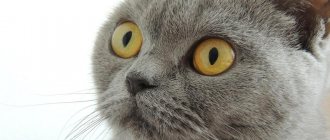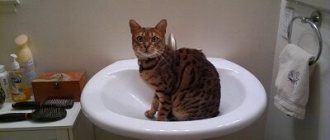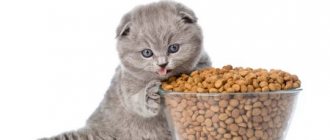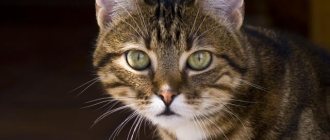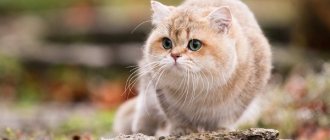When purchasing a kitten, you need to understand that the animal is not a toy: the baby needs care and attention. British shorthair kittens have a plush, dense coat (due to the thick undercoat). Longhaired British kittens also have a thick coat, but the hairs are longer, so they need more grooming and frequent brushing. British kittens: care, education and feeding - how to do it all correctly? Read about this in our article.
British kittens: care, education and feeding
Where is the best place to get a kitten?
It is better to purchase a British kitten from nurseries; it is advisable to find reviews (they must be positive about this breeder). When the kitten turns 3 months old in the nursery, it will be ready to move to a new family, and the breeder will be able to prepare the necessary documents and give the baby vaccinations. This age is also favorable for the baby himself; his immunity will be more or less formed, which means the kitten will get sick less.
Before taking the baby to a new home, you need to examine him so that there is nothing suspicious in appearance and the kitten looks healthy and active. Ask the breeder about the maintenance of the kitten, its nutrition, and read the pedigree of the parents.
Before purchasing a kitten, it is important to study its pedigree and talk to the breeder.
British kittens are distinguished from others by their plush dense coat, round eyes, compact, muscular body with a wide chest. These kittens also have a thick tail and full, short legs. The head should be round, with a wide muzzle, dense nose pads and cheeks.
When purchasing a kitten from a specialized nursery, you can be sure that:
- kitten from purebred parents;
- the veterinary passport reflects all vaccinations performed, including treatment against helminths;
- the kitten will have the metric to participate in exhibition events.
Characteristics of the British cat
more about the standard, characteristics of a British cat , as well as caring for it on our website.
What documents should there be?
An important aspect of purchasing a kitten is the preparation of its documents . The first of them is the generic metric. It is drawn up and certified by a representative of the club where the mother cat is registered, after examining the one and a half month old kittens for compliance with the breed and identifying possible defects. The document contains basic information about the baby:
- Name;
- floor;
- breed;
- color;
- Date of Birth;
- registration number in the stud book;
- information about parents.
At the time of purchase of a British baby, the metric may not be available if a pedigree has already been compiled on its basis . It is issued when the kitten reaches six months. The document contains the pet's details:
- Name;
- floor;
- belonging to the breed;
- color;
- Date of Birth.
Important! There are known cases of catnapping - the theft of expensive purebred cats for the purpose of resale or extortion of ransom. In this case, the proven actions of the thief are regarded as an administrative or criminal offense.
In addition, the pedigree contains:
- detailed information about parents and other ancestors up to the fourth generation on both lines, listing names, titles, awards;
- all details of the club, certified by the signature of its chairman and a wet seal.
Without this document, a British person will be considered mongrel, regardless of how much he meets the requirements of the standards.
A veterinary passport is issued at the time of the kitten’s first vaccination . It also indicates the main “personal” information about the baby - name, gender, color, breed, date of birth - and date, type of vaccination. Subsequently, the document records all data on repeated vaccinations and dewormings. Without a passport, a kitten will not be able to take part in exhibitions, or go on a long voyage by train, plane, or cross the state border by any means of transport.
In addition to the birth certificate, pedigree, and veterinary passport, a bilateral agreement is required between the breeder and the buyer, which specifies:
- terms of a transaction;
- breed, color, gender and date of birth of the kitten;
- the name of the club in which the mother cat is registered;
- price.
This document confirms the buyer's ownership of the pet. The owner of an animal subjected to catnapping has the opportunity to receive compensation for material damage. To do this, you need to confirm your claims with the pet’s documents and a link to the contract, which defines the owner’s rights and the price of the kitten at the time of purchase.
Return to content
When to adopt a kitten?
The ideal age for moving to a new family is 3 months (12 weeks). During this time, the kitten receives the necessary nutrition from the mother, breast milk actively builds immunity, and also allows the baby to develop properly. It is at this age that kittens already weigh about 2 kg. Also at this age, kittens learn from their mother the rules of behavior and caring for their appearance. A responsible breeder provides the necessary vaccinations up to 3 months and carries out preventive work, treating babies against helminths.
The ideal age for a kitten to move to a new family is 3 months.
British silver tabby color: types of color
British tabbies (British silver tabby) can be of the following types:
- blue silver striped BRI as 23;
- lilac silver striped BRI cs 23;
- chocolate silver striped BRI bs 23;
- cinnamon silver striped BRI os 23;
- fawn silver striped BRI ps 23;
- red silver striped BRI ds 23;
- cream silver striped BRI es 23;
- tortoiseshell silver striped BRI 23;
- bicolor silver striped BRI 23;
- silver color-point striped BRI 23;
- mixed colors (striped bicolor, striped tortoiseshell, striped tortoisebicolor, etc.).
What should you buy for a British kitten?
Before purchasing a baby, you should take care and buy a few necessary things that play an important role in the life of the future pet.
For a British kitten you need to purchase:
- tray. Pet stores offer a large selection of trays of different sizes and heights. You can start with a small litter box, but as your pet grows, you will need to replace the litter box with a larger one. There are also trays with adjustable side heights (consists of a tray and an additional extension); Their advantage is that while the kitten is small, it can go into a tray with low sides. as soon as it grows up, the height of the sides can be increased by attaching the second part;
- First purchases - a tray and a bowl for a kitten
- scratching post It is necessary so that the baby can wear down his claws and keep the furniture and wallpaper intact. You need to immediately show the kitten why this thing is at home by running the kitten’s paws over the scratching post a couple of times. British cat babies are very smart and quickly learn to use this item;
- toys. To develop dexterity and strength, kittens need a variety of toys; there are a huge number of them in pet stores (balls, teasers, mice, laser toys);
- Buy your kitten a variety of toys so he doesn't get bored.
- tools and supplies for pet care. Scissors for trimming nails, a comb for combing hair, the necessary shampoos for washing - all this can be picked up in specialized stores.
Table 1. Annual kitten care calendar
| Term | Procedure |
| 1 time per year | Preventive vaccinations (rhinotracheitis, calicivirosis, panleukopenia, rabies), urine testing for urolithiasis (urolithiasis) |
| Once every 6 months | Prevention of helminthiasis |
| 2 times a month | Nail trimming, ear and eye cleaning |
| 4 times a month | Preventative examinations of ears and eyes, combing |
| Daily | Preventative examination of external condition |
Video - British Shorthair cat
Tabby colors
The main signs of a tabby (or wild color) are the letter M located on the animal’s forehead (according to legend, this is the sign of a scarab), dark stripes near the eyes and on the cheeks, as well as rings (necklace) on the neck and chest.
Marbled Tabby
Dark circles, swirls and patterns on a light background. The pattern should be clear, not tangled or intersecting.
Spotted Tabby
Stripes on the cheeks, a dotted stripe along the ridge, and spots on the sides, preferably clearly defined and bright, are required. The cat is a micro-leopard.
Striped tabby
Brindle (sprat, mackerel, striped) is the most common tabby color. Mackerel (mackerel) fish, as well as sprat fish, have tiger stripes on their scales, just like cats have on their fur, hence the name.
Distinctive features are a dark stripe along the ridge, extending onto the tail, and striped sides. It is important that the stripes are not interrupted and do not turn into spots. The cat is a micro-tiger.
Patterned with white (torbico)
Quite a rare color, consists of three: tabby, tortoiseshell, white. On a white background there are colored spots with one of the tabby patterns.
Pictured tortoiseshell (torby)
The animal has a tabby pattern under any of the coat colors (black-red, chocolate-red, blue-cream, lilac-cream, as well as cinnamon-red and fawn-cream).
Silver tabbies
The cat's fur has a black pattern (stripes, spots, marble), and a white and silver undercoat.
Golden tabbies
The cat's fur has a red pattern (stripes, spots, marble), and an apricot undercoat.
British kittens weight
This breed is large and massive, so British kittens are heavy. The weight of a newborn British kitten is about 130 g, and within 7 days their weight reaches 150 g. During this period of time, kittens actively feed on their mother's milk. The nutrition of a nursing cat plays an important role in the nutritional value of milk: its diet must be additionally fortified, so the mother of the kittens is fed specialized food or natural food with added vitamins.
Table 2. Kitten weight at different age periods
| Age | Cat weight | Kitty weight |
| Newborn | 70-140 g | 60-140 g |
| 1 Week | 240-260 g | 110-250 g |
| 2 weeks | 340-400 g | 150-360 g |
| 3 weeks | 400-630 g | 210-420 g |
| 4 weeks (month) | 550-740 g | 250-600 g |
| 2 months | 1-1.7 kg | 450-900 g |
| 3 months | 1.5-2.5 kg | 1.5 kg |
| 4 months | 2.1-3.9 kg | 1.7-2.4 kg |
| 5 months | 2.6-4.3 kg | 2.2-2.9 kg |
| 6 months | 3-5.4 kg | 2.3-3.6 kg |
| 7 months | 3.3-5.6 kg | 2.4-3.9 kg |
| 8 months | 3.5-6 kg | 2.5-4.1 kg |
| 9 months | 3.8-6.4 kg | 2.5-4.3 kg |
| 10 months | 4.1-6.7 kg | 2.5-4.4 kg |
| 11 months | 4.3-6.8 kg | 2.5-4.5 kg |
| 12 months (year) | 4.5-7 kg | 2.5-4.6 kg |
British kittens have quite a large body weight
A little about the breed
It is believed that British Shorthair cats trace their ancestry back to the famous Cheshire cat. But seriously, this is one of the first officially recognized and standardized breeds: already at the first London cat show in 1871, the British were widely represented.
British cats have dense, plush fur.
British Shorthair cats have a strong build, developed pectoral muscles, a short thick tail, strong dense legs and a round massive head. A captivating feature of their appearance is their thick cheeks and round amber eyes. Another distinctive feature of the breed is its dense, plush coat. More than 60 color variants are recognized, but the main ones are lilac and blue.
British cats have round amber eyes
The first days of a kitten in the house
The new resident first needs to adapt: find out where the toilet and food are. In addition, he will look for his mother and call her loudly. New smells and new family members frighten the pet, so it will be natural for the baby to hide in a dark place.
How a kitten gets used to a new home goes like this:
- In the first days, you need to leave the kitten alone and try not to forcefully hold it in your hands if it breaks free and avoids attention. It’s better to start getting acquainted with the kitten, communicating with it in a gentle tone, then the pet can overcome fear and meet you halfway. Also, do not make loud, sharp sounds, which can greatly frighten the new tenant;
- provide the opportunity for the baby to gradually master the territory of the new home. To begin with, let the kitten stay in one closed room for several days, where there will be bowls of water, food and a tray. However, the toilet and food should not be located close together; try to place them far away from each other, but not so that the baby cannot find them. After a few days, when the kitten gets used to it, you can let your pet explore other rooms;
It is necessary to get acquainted with the new tenant gradually, without making loud sounds or making sudden movements
- Usually three-month-old kittens have already been trained by a cat to go to the litter box, but stress and new smells can confuse the baby. Therefore, be patient and be vigilant, as soon as the kitten wants to go to the toilet, immediately move it to a new tray and after all the work, do not wash it for a while so that the kitten can recognize the toilet by the smell. It is best to take a little litter from the tray where the kitten went with its mother, this will make getting used to the new toilet easier;
- Feeding your baby should not change dramatically. Ask the breeder what the kitten ate before moving and at first strictly feed the pet the same diet. The change of food should be smooth: you need to gradually mix the new food with the usual one, otherwise the gastrointestinal tract of a small pet may be disrupted.
In a house where there is a kitten there must be a scratching post
Toilet training a kitten
As soon as the kitten appears in the house, you need to immediately accustom it to the new tray. At first, the baby may be disoriented in a new room and needs help. You also need to consider the location and access to the toilet, because British cats, although clean, have their own opinions. Therefore, if a kitten refuses to go to the new litter box, then you should not think that he is stupid and does not understand anything. In fact, British cats are very smart, and therefore, most likely, the new tenant simply does not like something. Perhaps the tray needs to be moved a little, moved to another corner, or the filler changed.
Instincts tell the kitten that all waste needs to be buried, so choose the appropriate substance for the toilet, because the “British” are clean. If you do not pay attention to this, the kitten may begin to mischief and look for another place to relieve itself.
Training a kitten to use the litter box
If you suddenly find a puddle on the floor, you should not scold the kitten, much less beat it; with this method of education you can provoke the baby to do things secretly in the wrong place. It is better to show your pet in a dissatisfied tone that you are not happy with this situation, and, having collected the puddle with toilet paper, take it to the tray. This way the smell will attract the kitten to go to the right place. It is also worth watching the animal; usually after the baby has eaten, he runs to the toilet. Monitor the kitten's path to the toilet, and then the baby will remember that things need to be done in the litter box.
Don't lose your temper if the kitten doesn't go to the toilet the first time. Remove puddles with special odor-eliminating products that can be purchased at a pet store. Be persistent with your pet and show him where to go, but do not hit him or scream if he suddenly misses. The kitten will sooner or later understand what is required of him, the main thing is to be patient.
In the nursery, cats teach kittens to be clean, so babies come to their new home with toilet knowledge
Health
Newborn British kittens gain good immunity by being close to their mother for a long time. Within two weeks, their first teeth appear. You need to make sure that there is no inflammation of the gums.
Before vaccination, deworming must be carried out 10 days. Adult animals need to be given deworming medicine once every 3 months, especially if they go outside.
Although the British kitten is in good health, once you decide to have a baby, be prepared to pay attention to warning signs. If the cat constantly meows, is lethargic, and does not eat anything, then something is bothering her, but you should not make a diagnosis yourself. A veterinarian is qualified to identify diseases and treatments.
First moult and grooming
A kitten's first shedding occurs at seven or eight months of age. During the week, the kitten should be carefully combed every day with a special comb, running through the fur with massage movements. After this procedure, you can walk over the fur with your hand in a wet rubber glove, thus collecting the remaining fur. Subsequent molting occurs on an individual basis, depending on many factors - vitamin deficiency, allergic reactions, existing diseases, age-related and hormonal changes, and the use of inappropriate bathing products.
Regular grooming of the British dog's coat with special combs will preserve the beauty of the coat.
You need to groom your pet regularly:
- weekly brushing will bring many benefits to your pet. Firstly, this procedure will rid the cat of dead skin particles and fur hairs, which means that when licking, less of them will end up in the stomach. Secondly, regular brushing gives the animal a healthy and well-groomed appearance;
- if you accustom your kitten to water procedures from an early age, then bathing can become one of your pet’s favorite activities, which can be used both when soiled and for preventive measures;
- Careful trimming of the claws will rid the pet of the rough, keratinized part, which flakes off over time, causing the claws to begin to cling and cause discomfort to the cat. The procedure is short, only a couple of times a month. The haircut is carried out with special scissors, carefully so as not to damage the blood vessel;
- regular preventive examination of the auricle and organs of vision, when the cat’s ears are cleaned of wax accumulation, and the eyes are wiped with black tea infusion or eye drops.
From an early age, a kitten needs to be accustomed to the necessary procedures, then he will calmly endure them and even enjoy them
How to brush British cats?
Before purchasing a British kitten, you should buy special combs at a pet store. To care for your pet you will need:
- a comb with metal teeth with rounded ends so as not to injure the animal’s skin. Needed for primary combing of wool of any length in the direction from head to tail according to hair growth;
- comb with massage effect. Stimulates blood circulation, provides beautiful fur for your pet by combing out dead skin particles and dead hairs. You need to comb your pet with such a comb carefully so as not to damage the delicate undercoat;
- rubber brush or glove. Helps complete your pet's grooming routine. With the help of such a brush you can remove remaining hairs from the surface of the coat after active combing.
A variety of pet grooming products to choose from allows you to keep your cat's coat healthy and beautiful.
Bathing
The first bath of a kitten should be careful and not earlier than one month of age, so as not to scare the baby and not instill a negative impression of the procedure. It is better to teach the kitten to bathe in a playful way, touching the kitten with wet hands, and then gently moistening the baby’s fur with a few drops of warm water. This way, the kitten won’t get scared and won’t start to struggle, and the water, rolling off the fur, will attract attention and interest.
Gradually, with the help of play, the kitten will get used to the water and will allow its body to be completely wet, while you can also gradually begin to use special shampoos that do not have a strong odor. The only exception can be shampoos against parasites, the pungent smell of which can scare away the “British”. Bathing a pet kept in an apartment should not be done more than once every two months, unless treatment or severe contamination of the animal forces it to be done more often.
What do you need to know? The shampoo should be selected based on the length of your pet’s coat and its color, as some products are designed to enhance the color of the animal’s coat.
A kitten's first bath should be no earlier than one month of age.
Bathing stages:
- fill the container with water, adjusting its temperature (about 30 °C);
- pour a special shampoo into the water that suits your pet;
- place the cat in a container with soapy water and gently, massaging the fur, wet the cat’s body;
- rinse off the product with clean warm water, being careful not to get it into your ears, they are very sensitive;
- After bathing, wrap the cat in a dry towel to thoroughly dry the wet fur;
- Place your pet in a warm, draft-free room.
If you gradually accustom your kitten to water procedures, then over time he will enjoy the process and will not be capricious.
Choosing the gender of the kitten
Choosing a gender ceases to be difficult if you clearly understand the purpose for which you are purchasing a pet. If a British kitten is purchased as a pet, without the prospect of participating in breeding work, then it does not matter much whether it is a cat or a female cat. Typically, the breeder recommends sterilizing such an animal and has the right to include a corresponding condition in the contract if he does not want the kitten to participate in breeding work in the future.
Quite often the practice is to sell already sterilized kittens . In this case, they choose the baby who is liked more than the others, is more active, and has some special features that distinguish him from other brothers.
Important! If the new owner has to decide on the issue of sterilizing the pet himself, it should be taken into account that with approximately the same degree of complexity and cost of operations, regardless of the gender of the kitten, the postoperative period in cats lasts 3-5 days longer.
If a kitten is purchased for breeding, the question of sterilization is removed: the pet, regardless of its gender, needs regular matings throughout its active life. The main difficulties for the owner lie in maintaining breeding animals.
- The behavior of a cat characteristic of the mating season, if mating does not occur, can only be tolerated by an absolutely insensitive person. This situation can be leveled out by timely selection of a worthy partner (on your own or with the help of the club where the cat is registered) when the time for the planned mating approaches. At this point, the cat must be vaccinated against infectious diseases.
- Breeding cats need the company of partners every month, and in their absence they lose their conditioning qualities, become irritable and, what is especially unpleasant, begin to leave marks. As a rule, the cat's owner becomes the receiving party for mating. He is also responsible for the health and life of the arriving guest, providing an area for courtship so as not to disturb the animals.
If these points are not a priority when choosing a kitten, the owner should know that gender affects the size and development of an adult animal: British cats are imposing, massive, textured, while female cats are more miniature and dynamic. And, of course, you need to take into account the character traits of the cat.
Important! But regardless of gender, a pet will always feel the need for love and attention from a person.
British gentlemen are distinguished by their discreet friendliness towards all family members, their self-sufficient character and are completely unobtrusive. Ladies are more capricious and selective in their habits and behavior, while being unusually clean, smart, attached to one person (usually a man), sometimes showing jealousy and possessive feelings.
Return to content
Upbringing
Before adopting a British breed kitten, it is worth considering that these are wayward animals. Therefore, education should begin from the first days of the kitten’s appearance in its new home. One of the main lessons of education is litter box training. If the kitten does not know that all tasks must be done in a specially designated place, then you need to show him how it is done. If the baby is already trained (usually in nurseries, kittens at the age of 3 months are toilet trained), then you just need to make sure that the pet gets used to the new tray. It is better to immediately show the animal what and how to do, because neglected training will be difficult to correct.
At first, carefully track the kitten’s path to the toilet, so you can teach him to do the necessary things in the right place
During education, force should never be used. British cats are smart, and therefore only a dissatisfied raised tone or clap of the hands can be applied to them, otherwise, when force is used, they can harbor anger or begin to be mischievous. For training, it is better to use repellents with a pungent odor or the smell of citrus fruits, a spray bottle with water, to wean the animal from sharpening its claws on furniture or doing dirty tricks in an inappropriate place.
If the kitten begins to shit, then try to find the reason in the location of the toilet or the composition of the litter
It is also worthwhile to immediately accustom the kitten to the scratching post so that it does not damage the furniture by grinding down its sharp claws. To do this, you need to show the baby several times, running your fingers along the post of the scratching post. You can also use catnip by rubbing dry grass on a post; the smell will attract the kitten’s attention, and he will involuntarily begin to touch the scratching post with his paws.
During games, try to make do with teasers and other toys; do not teach the kitten to play with your hands.
In general, training is not difficult, since the “British” cats are very smart cats, but you should immediately show who is boss in the house by establishing eye contact with the pet, while forbidding him to do nasty things so that he understands the boundaries of what is permitted.
Little “Britons” love to play, so pay more attention to games with your furry fidget
Feeding a kitten with natural products
List of foods not recommended for cats:
- fatty meats (pork, lamb);
- raw poultry meat and bones (chicken, turkey);
- any raw fish;
- sausages, sausages, smoked cheeses, chocolate, etc.;
- food that a person eats (salty, spicy, sweet).
A diet based on natural products includes the following items:
- lean meat (frozen beef, chicken, turkey, rabbit) - about 8-100 g/day. depending on the age of the kitten;
- offal (liver, heart, kidneys) - 10-100 g/day;
- boiled sea fish without bones no more than once a week gj 6-80 g/day;
- dairy products (cottage cheese - 3.5-20 g/day, kefir, low-fat sour cream no more than 10 g per day, cheese);
- chicken and quail eggs in the amount of 50-55 g per week;
- vegetables (cucumber, carrots, cauliflower, zucchini) - 10-40 g/day;
- cereals (buckwheat, wheat, rice) - 10-80 g/day;
- vitamin and mineral complex (according to instructions).
A balanced diet is the key to the correct and healthy development of the baby.
Table 3. Kitten consumption rate of natural food
| Age | Number of times per day | Daily norm |
| 1-3 months | 5-6 times | 150 gr. |
| 4-6 months | 4-5 times | 240 gr. |
| 7-10 months | 3-4 times | 280 gr. |
| More than 10 months | 2 times | 250-300 gr. |
What do you need to know? Choose wide, flat dishes for your pet to make it easier for him to eat.
Dry food for British kittens
If you decide to choose dry food for your pet, then it is important to consider that “Whiskas”, “Kiticat”, “Purina”, “Friskies”, “Felix” and similar low-quality foods are not suitable for a complete healthy diet. They contain a huge amount of flavors, dyes, taste enhancers and other harmful chemicals, which cause many diseases associated with urolithiasis and gastrointestinal tract disorders. It is better to use high-quality industrial feed, which is completely ready for consumption.
Each manufacturer has its own calculation table for feeding a kitten by month, so you just need to follow the recommendations and make sure that the kitten always has access to fresh water. The main thing is to choose high-quality food for your kitten from a good holistic, superpremium or premium manufacturer. Then you can be sure that the baby will grow up healthy and strong.
Brit food for kittens
Dry and wet food that can be fed to a British kitten:
- Among the good holistic foods for kittens you can buy: Eukanuba, Brit, PronatureHolistic, Primordial. The advantage of this class of food is that it is hypoallergenic. The diets have an optimal ratio of proteins, fats and carbohydrates, and also contain dietary supplements;
- super premium food: Hill's Science Plan, Orijen, Now Fresh, 1st Choice, Schesir;
- premium food: Pro Plan, Happy Cat, Leonardo, Brit Premium, Royal Canin.
What do you need to know? If the kitten ate industrial food in the nursery, then you should not immediately start feeding it natural food or other dry food, as this can disrupt the functioning of the gastrointestinal tract and lead to complications. Therefore, find out what brand of dry food the kitten was eating, and feed it this particular food for the first time. The transition should be smooth: gradually mix in other food to avoid health problems for the baby.
Choose high-quality food from a well-known manufacturer for your pet


